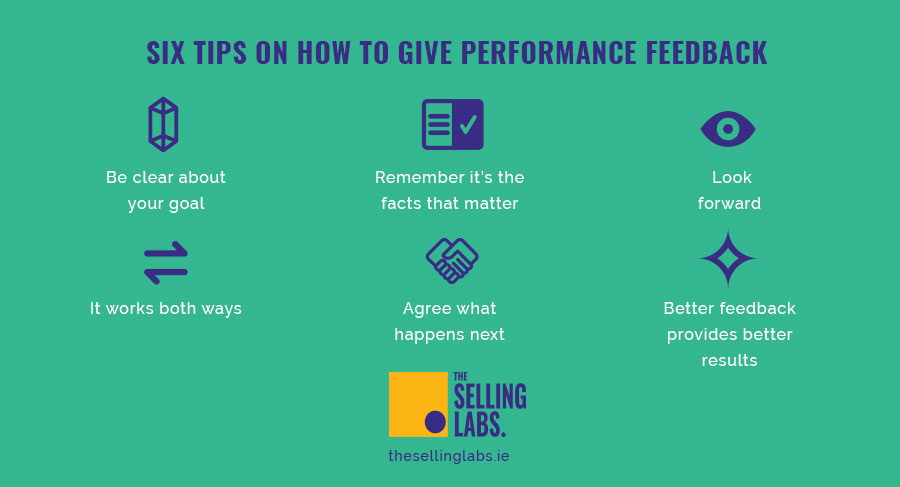To improve your team’s performance do you provide regular feedback on how they do their job?
How to give feedback and make it stick is a common question I get asked when I coach leaders. Perhaps you use different approaches to help your team’s performance: pipeline analysis, sales figures, shadowing. However in my experience, as a former sales leader, few interventions are as powerful as feedback from you.
How To Provide Feedback That Creates Change
Sharing an observation after you’ve shadowed your team with a client or insights on how they handled a difficult situation is motivating and instructive and is in itself a sales team motivation strategy. But, few leaders do it effectively! They shy away from it, finding the directness uncomfortable. When feedback is delivered in the right way and at the right time, it can dramatically change the relationship between you and your team and has a lasting effect on their ability to do their job.
Our blog below provides insights on how to give feedback that will have a permanent impact on sales confidence and performance.
The Vital Importance of Feedback – It’s The Way You Tell’Em!
Picture this. Dashboard in front of you on your laptop screen on a Sunday night before the Monday morning business review. You’re feeling anxious. The sales results just aren’t up to scratch and time is ticking by. Under pressure, you decide that urgent feedback is required. Right here. Right now! So you crack your knuckles and start typing and in two minutes you’ve written up a strongly worded email, scolding the team for the poor forecasting that’s led to this big dip in Q1 performance. Admiring your own frankness and the no-nonsense style in which you’ve just scripted the piece, you triumphantly raise your fist and then hit SEND!
But, of course, it doesn’t take long for you to regret being so hasty.
With the perspective that distance brings you realise that this effort at ‘feedback’ will really only annoy or alienate the team and make them defensive and resentful rather than go any way towards solving the problem. This is an urgent issue after all, and, as you already know from experience, for feedback to be effective, it has to be timely, transparent, accurate and helpful! Your email was none of these things so rather than write a follow-up one, you opt instead to try a different approach altogether!
Good choice!
Why Is Good Feedback Important?
Feedback is an essential component of any sales methodology or indeed any communications approach. It is that vital intervention that hones and lubricates the various parts in the machine so that it runs smoothly and efficiently time and time again. Regardless of your style of sales leadership receiving regular and meaningful feedback from the direct manager is essential to propagate the good practices that drive both an individual’s and a team’s success and to weed out the problems or issues that hinder progress.

But while delivering regular feedback is vitally important to safeguard success, the way you deliver it is arguably more so. A furtive dressing-down sent from a remote location on a Sunday night is unlikely to impress and motivate any team member as it simply undermines his or her confidence and creates avoidable tensions and anxieties. But a frank assessment, delivered in a structured and transparent manner that takes account of the team member’s point of view, is likely to clear the gangways, raise the spirits and guarantee improved results.
So getting back to our opening example. How could we have done a better job of telling our team that Q1 numbers are under target and that we’re worried that we are falling behind?
Six Tips On How To Give / Write Performance Feedback
- Be clear about your goal – What is the problem and what do you want people to think, feel and do following the feedback? Is the message the same for everyone on the team? Their performance is rarely identical so why should their feedback be.
- Remember it’s the facts that matter – There should never be any ulterior motive when offering feedback. Rather than personalising or politicising and doling out blame for what’s wrong, leaders should instead concern themselves with identifying the changes that will fix the problems and deliver the best outcomes.
- Look forward – Nothing will improve unless everyone is clear on what needs to happen differently (or, in the case of positive feedback, what you want the recipient to continue doing). Depending on what the recipient has to say, this may involve talking through different options; or it may be clear cut, based on the team’s targets, processes, etc.
- It Works Both Ways: Feedback is a two-way conversation, not an email issuing instructions. Everyone likes to have an input into what they are asked to do. Don’t blindside the recipient. Instead, arrange a time and place to talk. Feedback isn’t about you having your say; it’s about a conversation focused on good performance. After all, you may be mistaken about some of the facts, or they might have a different but valid viewpoint. If you’ve kept your language factual and neutral so far, that lays a foundation for any conversation to be likewise.
- Agree what happens next. Well-delivered feedback results in agreement on the next steps. That’s not to say that everybody’s happy, but that there’s a common understanding of the issue and agreement on the action to be taken.
- Better feedback provides better results. Ideally, you want to build a culture of feedback in a sales team. At a basic level, feedback is about letting people know how they’re doing so they can either carry on doing well or do better. Once a year, in an awkward performance review, is too little, too late. Feedback should be happening regularly for a constant awareness of performance levels, with no surprises.

How to Deliver Feedback Effectively
Two simple ways to begin building a regular and interactive two-way feedback culture include:
- Regular 1-to-1s between you and each team member so there is scheduled time to review issues and both you and the team member has a chance to voice your opinions
- Peer conversations between team members focused on one explaining a specific sales issue or challenge and the other listening before asking questions and offering insights and pointers. This can be transformational as it helps high performing team members help others who may be struggling and it creates constructive bonds in the team.
Remember, issues are best resolved when everyone involved has an input into solving the problem and plays their part in finding the optimum solution. Offering feedback in an honest, open, clear and trustworthy way is by far the best policy as it ensures that everyone is in no doubt about what needs to be done in order to deliver the best results.
It’s good to talk after all!

Master The Art of Providing Feedback To Your Sales Team
For more help on this how to provide feedback to your sales and other sales manager and leadership challenges just contact me online now and I’ll get back to your message asap.



